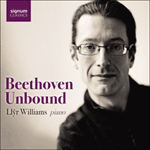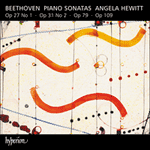
Welcome to Hyperion Records, an independent British classical label devoted to presenting high-quality recordings of music of all styles and from all periods from the twelfth century to the twenty-first.
Hyperion offers both CDs, and downloads in a number of formats. The site is also available in several languages.
Please use the dropdown buttons to set your preferred options, or use the checkbox to accept the defaults.
The Presto alla tedesca (‘In the German style’) designation of the sonata’s opening movement looks forward to the Alla danza tedesca third movement, likewise in G major, of Beethoven’s late String Quartet Op 130. Curiously enough, the quartet’s theme is an exact inversion of the sonata’s opening subject. Beethoven’s sketch for the sonata’s initial subject shows it in a dance-like form, and in a regular eight bars. The final version is less symmetrical, but Beethoven appears not to have forgotten his simpler original idea, and he returns to it in the movement’s coda, where the melody’s phrases are shared between the pianist’s two hands. Beethoven clearly enjoyed the notion of ending the movement with what sounds for all the world like a contredanse, and he even added acciaccaturas (‘crushed’ notes which make it sound as though two adjacent notes are being played simultaneously) to the melody, as though in imitation of a village band. As for the movement’s central development section, it is mainly based on the main theme’s ‘cuckoo-call’, involving some crossed-hands gymnastics which are by no means easy for beginners to negotiate.
The middle movement is a melancholy barcarolle in the minor, and the sonata comes to a witty close with a rondo whose theme looks forward to another of Beethoven’s late works: its harmonic outline is the same as that of the opening subject in the Sonata Op 109. Following a central episode rather like some miniature ‘Rage over a lost penny’, Beethoven returns to the rondo theme in the middle of a continuing phrase, so that the reprise seems to begin in mid-stream. It is a witty touch, and one that is matched by the charming effect of the work’s gently understated ending.
from notes by Misha Donat © 2010
L’appellation Presto alla tedesca («à l’allemande») du premier mouvement de la sonate annonce le troisième mouvement Alla danza tedesca, également en sol majeur, du Quatuor à cordes, op. 130, de Beethoven. Assez curieusement, le thème du quatuor est le renversement exact du premier sujet de la sonate. Beethoven avait esquissé le sujet initial de la sonate en forme de danse et sous une carrure de huit mesures. La version finale est moins symétrique, mais Beethoven semble ne pas avoir oublié son idée originale, plus simple, et il y revient dans la coda du mouvement, où les phrases de la mélodie se partagent entre les deux mains du pianiste. Il est clair que Beethoven a aimé terminer le mouvement avec ce que tout le monde considère comme une contredanse, et il a même ajouté des acciaccaturas (notes «serrées» qui donnent l’impression de deux notes adjacentes jouées simultanément) à la mélodie, comme pour imiter une fanfare de village. Quant au développement central du mouvement, il repose essentiellement sur le «cri du coucou» du thème principal, qui implique une gymnastique de mains croisées pas du tout facile à négocier pour les débutants.
Le mouvement central est une barcarolle mélancolique dans le mode mineur, et la sonate arrive à une conclusion spirituelle avec un rondo dont le thème annonce une autre œuvre tardive de Beethoven: son profil harmonique est le même que celui du premier sujet de la Sonate, op. 109. Après un épisode central qui ferait penser à une toute petite «colère sur un sou perdu», Beethoven revient au thème du rondo au milieu d’une phrase continuelle, si bien que la reprise semble commencer à mi-course. C’est une touche spirituelle assortie à l’effet charmant de la conclusion douce et discrète de l’œuvre.
extrait des notes rédigées par Misha Donat © 2010
Français: Marie-Stella Pâris
Die Presto alla tedesca („im deutschen Stil“) des ersten Satzes der Sonate weist voraus auf den dritten, ebenfalls in G-Dur stehenden Satz von Beethovens spätem Streichquartett op. 130. Seltsamerweise ist das Thema des Quartetts eine genaue Umkehrung des einleitenden Themas der Sonate, das Beethoven zunächst in tänzerischer Form in acht gleichen Takten skizzierte. Die endgültige Fassung ist weniger symmetrisch, doch hatte er seine ursprüngliche einfachere Idee offenbar nicht vergessen und kehrt in der Coda des Satzes zu ihr zurück, wo die melodische Phrasierung auf beide Hände verteilt ist. Offenbar fand er Gefallen daran, den Satz mit einer Art Kontratanz abzuschließen und bringt sogar Acciaccatura-Verzierungen (unmittelbar vorausgehend oder gleichzeitig kurz angeschlagene Nachbartasten) als Anklang an eine Dorfkapelle in die Melodie ein. Der Entwicklungsteil des Mittelsatzes baut weitgehend auf dem Kuckucksruf des Hauptthemas auf und erfordert einiges Übergreifen der Hände, was für Anfänger keineswegs einfach ist.
Der mittlere Satz ist eine melancholische Barkarole in Moll, und die Sonate schließt mit einem gewitzten Rondo, dessen Thema auf ein weiteres Spätwerk von Beethoven voraus weist: Die harmonische Anlage ist identisch mit dem Einleitungsthema der Sonate op. 109. Nach dem Mittelteil, einer kleinen „Wut über den verlorenen Groschen“, kehrt das Rondothema in der Mitte einer fortgesetzten Phrase zurück, so dass die Reprise unvermittelt einzusetzen scheint. Dieser gewitzte Einfall steht im Einklang mit dem charmanten Effekt, mit dem das Werk in zarter Untertreibung endet.
aus dem Begleittext von Misha Donat © 2010
Deutsch: Henning Weber
 Beethoven: Beethoven Unbound Beethoven: Beethoven UnboundA comprehensive new cycle of the Beethoven sonatas recorded live at London's Wigmore Hall during the pianist's epic fourth rendition of these masterpieces .» More |
 Beethoven: Piano Sonatas Opp 27/1, 31/2, 79 & 109 Beethoven: Piano Sonatas Opp 27/1, 31/2, 79 & 109Angela Hewitt’s next instalment of Beethoven, bookended by the great ‘Tempest’ and late E major sonatas.» More |

